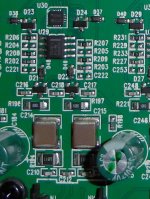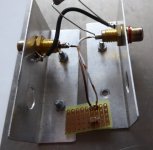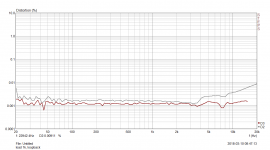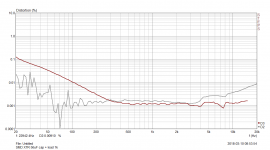Dunno, he said "Yes, but when you know for sure there is a difference, then you can start judging, knowing that you are not imagining it... Way, way too many start judging before they even know if there is a valid difference..."The test can prove whether there is an audible difference. What's the bull about not imagining things?
I have done it with both a Dauphine (many times) and a Porsche (a few times). It is just like listening to the music just for itself, if it is good, then the medium you use is secondary, however, if you want a sports car experience as well, then the Porsche is much better, e.g. high audio playback quality further enhances the experience.
Afoot? Too much Sherlock bingeing on Netflix, ol' chap? You are suggesting I have a hidden agenda and you are infantalizing my knowledge of control theory. No need for that; shall we stick to the higher ground of engineering analysis?
You have an equation in your data sheet that makes the effects of the output buffer completely vanish into thin air "by simple subtraction".
This should not be a surprise because "error cancellation" by feedback is impossible except hypothetically in academic's margin notes.
Sounds like an agenda to me, and an offhand attack on other peoples work.
C-C looks like subtraction to me, so what if it fails at high f the results are posted please comment on my points and the actual data and drop the editorializing. Again as a point of discussion, if the buffer is modeled as an exact G = 1 with no frequency limitations it is simply C-C = 0.
Should we say error reduction rather than cancellation? Such a commotion around a circuit where nothing but a simple capacitor added to an already finished circuit had an unforeseen benefit.
John Linsley Hood has written that while developing a power amp his cat would leave the room if it disliked the current modification....
On my point of view, this endless controversy about blind tests VS not blind is boring.
Blind tests are, for sure, useful for two things.
It is the only way to get a "proof". So, it is useful if you want to make a theoretical study about average audibility of people and if you want to lift an uncertainty for yourself.
When some want to make his own opinion on some electro/acoustic gear, in relation to "hifi", or to take design decisions, he is free to choose the methods he think the best for him. I don't need any blind tests to figure out which restaurants I prefer.
I notice one thing. Supporters of "blind tests" would like to impose their "personal" points of view on everyone, the others only choose the methods that best suit them, according to the circumstances. Of course the points of view are subjectives, if they are not scientifically proven. These are just opinions. And I have been taught to respect those of others, even if they differ from mine. More than this, they can enrich mines, sometimes, giving me the desire to check on my own.
Blind tests are, for sure, useful for two things.
It is the only way to get a "proof". So, it is useful if you want to make a theoretical study about average audibility of people and if you want to lift an uncertainty for yourself.
When some want to make his own opinion on some electro/acoustic gear, in relation to "hifi", or to take design decisions, he is free to choose the methods he think the best for him. I don't need any blind tests to figure out which restaurants I prefer.
I notice one thing. Supporters of "blind tests" would like to impose their "personal" points of view on everyone, the others only choose the methods that best suit them, according to the circumstances. Of course the points of view are subjectives, if they are not scientifically proven. These are just opinions. And I have been taught to respect those of others, even if they differ from mine. More than this, they can enrich mines, sometimes, giving me the desire to check on my own.
Too sensitive to everything.Not true hi-impedance FET circuits can do fine with nothing over 1000pF. 50Meg and 1000pF is a pretty low f and works just fine.
Yes, before an audiophile claims a listening preference, it would be good if they demonstrate that they can hear an audible difference.Someone on another thread just made the point that an ABX test proves that we are not imagining a difference, so then we can move on to making a judgment about it
But the word 'prove' is a stretch. Likelihood is a better goal.
A proof is a proof. What kind of a proof? It's a proof. A proof is a proof. And when you have a good proof, it's because it's proven. - Jean Chretien
I'm glad that you guys got that sorted out. PMA has properly shown the problem with ceramic caps is: That COG caps never are large enough to be effective coupling caps. ONLY hi Q ceramics like the 7 series has enough maximum capacitance to be useful for a coupling cap, AND they distort BADLY! If some of you idealists would just MEASURE hi Q ceramic caps aggressively, you would find what PMA has found.
Not a single "idealist" disagrees with you here. It's widely known. It's been in app notes and datasheets for at least 15 years. Only an incompetent designer in "hi-fi" would use X, Y, Z dielectric caps for coupling or filtering.
These parts are used in both consumer and pro audio electronics, unfortunately. Ignorance of designers or cost dictate?
Yes, they "work quite well" even with X7R coupling caps, until you start to measure.The microphones worked quite well.
On my point of view, this endless controversy about blind tests VS not blind is boring.
Blind tests are, for sure, useful for two things.
It is the only way to get a "proof". So, it is useful if you want to make a theoretical study about average audibility of people and if you want to lift an uncertainty for yourself.
When some want to make his own opinion on some electro/acoustic gear, in relation to "hifi", or to take design decisions, he is free to choose the methods he think the best for him. I don't need any blind tests to figure out which restaurants I prefer.
Yawn. Yes we know the difference between objective proof and personal opinion or preference since, ohh, I don't know, several centuries?
Jan
Last edited:
The microphones worked quite well.
Indeed they did.
https://linearaudio.net/sites/linea...kHz) recorded Wurcer mic preamp nov 2011.flac
https://linearaudio.net/sites/linea..._recorded_with_Wurcer_mic_preamp_nov_2011.wav
Flashback: recorded in SY's living room.
Jan
Last edited:
The royal "we" ?Yawn. Yes we know the difference between objective proof and personal opinion or preference since, ohh, I don't know, several centuries?
OK, where did I find SMD MLCC X7R coupling capacitors? In microphone preamplifiers in consumer and pro sound cards and mixers of various manufacturers. One example is attached. Please note they use excellent OPA1602, on the other hand ....
Years ago I measured a 100nF, 40 years old Tesla X7R capacitor, which was used for supply bypass usually. I have now decided to repeat the measurement with some modern SMD X7R part. Tested capacitor has 56uF, load is 1kohm, which makes 2.8Hz(-3dB) low frequency corner. Quite reasonable, right. Please see loopback measurement (just 1kohm load only) vs. 56uF+1kohm measurement in attachments. Also a photo of the test fixture. (input voltage was 0.5V only).
Years ago I measured a 100nF, 40 years old Tesla X7R capacitor, which was used for supply bypass usually. I have now decided to repeat the measurement with some modern SMD X7R part. Tested capacitor has 56uF, load is 1kohm, which makes 2.8Hz(-3dB) low frequency corner. Quite reasonable, right. Please see loopback measurement (just 1kohm load only) vs. 56uF+1kohm measurement in attachments. Also a photo of the test fixture. (input voltage was 0.5V only).
Attachments
Last edited:
Many designers use 100pF ceramic caps to filter the Integrated circuit rails. because they are micro-scopic. Arguments against this use?These parts are used in both consumer and pro audio electronics, unfortunately. Ignorance of designers or cost dictate?
Many designers use 100pF ceramic caps to filter the Integrated circuit rails. because they are micro-scopic. Arguments against this use?
Generally speaking, no arguments, and 100pF will be most probably COG/NPO, which is fine.
On the other hand, supply rails/PCB tracks bypassing is not trivial and it should be verified that no interfering HF resonances have been created.
Don't you think you will lose something "emotional", looking to a photographic reproduction of a Van Gogh painting ? And worse if the white balance is wrong ?
The Next Rembrandt
Ah, they didn't forget the bumpy bits, that's what makes it different from a print. Other than that, a load of software engineers looking for the next product in a saturated market
- Status
- Not open for further replies.
- Home
- Member Areas
- The Lounge
- John Curl's Blowtorch preamplifier part III



